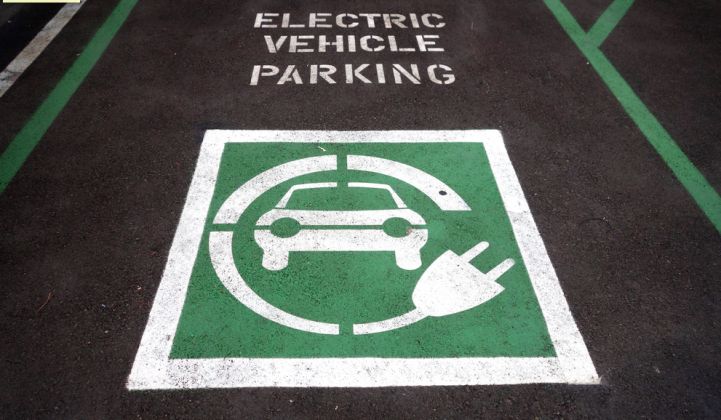Two of California’s biggest utilities have finally gotten the green light to move forward on plans to deploy electric-vehicle chargers as utility infrastructure -- at least, in pilot form.
Now it’s up to Southern California Edison and San Diego Gas & Electric to show that their approaches balance their role in bringing infrastructure to markets underserved by today’s EV-charging economics, while keeping the market open for non-utility actors. If they can, both utilities are hoping these pilots will lead to much larger deployments in the years ahead.
Last month’s approvals from the California Public Utilities Commission will allow SDG&E to spend $45 million to deploy 3,500 EV chargers under its Vehicle Grid Integration program and SCE to spend $22 million to support the rollout of 1,500 EV chargers as part of its Charge Ready program.
These are smaller rollouts than both of those utilities initially proposed back in early 2015, after the CPUC lifted a longstanding ban on utility investment in EV infrastructure. They’re also open to more involvement from customers and vendors in picking the EV-charging equipment and services to be involved, and how they’ll be priced and marketed to EV drivers.
But these changes were critical to winning the support of a broad group of stakeholders, including labor unions, environmental advocates, consumer groups, automakers and EV charging companies, in settlement agreements this summer that allowed the plans to move forward.
That’s not what happened with Pacific Gas & Electric’s EV charging proposals, which included more complete utility ownership and control over rate structures. Those proposals were denied by the CPUC last year, and are now being reworked for resubmission in the coming month.
SCE's and SDG&E’s programs differ slightly in their approaches. SCE, for example, will own all of the infrastructure except the EV-charging units themselves, while SDG&E will retain ownership of those chargers, along with the distribution lines, transformers and other gear needed to hook them to the grid.
But even though SDG&E will retain ownership of the chargers, “just like SCE, it preserves customer choice in the technology, it allows private companies to partner with us,” Pasquale Romano, CEO of EV charging startup ChargePoint, noted in an interview last week.
And while SCE won’t own the EV chargers it’s deploying, it “still gives you a rebate on the gear, and covers all the electrical upgrade and installation work,” he said. “It’s a simpler model than SDG&E’s. But from the site owner's perspective, they’re still covering about the same amount of the cost.”
Covering costs is a big reason why the CPUC decided to allow utilities to enter the EV-charging infrastructure business in the first place. In particular, both SDG&E and SCE are targeting workplace parking lots, where EVs can charge throughout the day, and multi-family housing such as apartment buildings and condos, which account for about half these utilities’ customers.
Multi-family housing has been a particularly tricky market for EV-charging investments, Romano noted, because “the electrical upgrades on the site dominate the costs.” Paying for these upgrades can account for up to 70 percent or more of an EV-charging deployment for apartment parking lots and structures, he said -- and those costs are borne by the landlord, not by the apartment dwellers.
“We already have programs for residents in apartments and condominiums that bundle the hardware into the service fee,” he said, nodding to the fact that ChargePoint and other EV-charging companies are offering financing for charging stations. “But the landlord has to foot the bill for a major upgrade. This is where utilities really come in and save the day.”
What the utilities get out of the deal is an opportunity to play a more active role in serving what may be one of their biggest new sources of electricity sales. California has been leading the country in electric vehicle adoption, and it has also placed a heavy burden on EVs to attain its long-range greenhouse-gas reduction goals, with a goal of putting 1 million zero-emission vehicles on the road by 2020.
As the number of plug-in vehicles starts to grow, their effects on grid will start to become more significant. So far, utilities have largely approached this challenge through pilot projects that allow control over EV chargers to limit their draw on the grid during times of peak energy demand. But variable pricing can also help guide when and how deeply EVs charge to accomplish similar results.
As part of its pilot project, SDG&E plans to introduce a dynamic pricing rate, which will charge less for power during times of low demand, and charge more during peak demand hours. The new rate also promises to encourage drivers to charge when renewable energy is plentiful, although SDG&E is still working out the details on that front, spokesperson Hanan Eisenman said last week.
EV drivers will be able to interact with these pricing signals through smartphone apps and web portals now under development, he said. Some of the variables drivers might input include how quickly they need to charge up, what price points they’re unwilling to pay, and whether they’d like to link their charging to the availability of renewable energy on the grid.
Romano pointed out that these EV-charging rates will be only indirectly passed through to individual drivers, however. It’s the commercial and multi-family housing owners who are paying the electricity bills, plus the EV-charging infrastructure providers like ChargePoint and its competitors, that will manage how changing prices interface with driver preferences.
There’s little doubt that EV industry players will be closely involved in how SCE and SDG&E roll out their pilot projects in the months to come. As the first large-scale deployments being funded by rate-based investments, they could provide an important model for how utilities and state regulators across the country approach their EV goals, he said.



